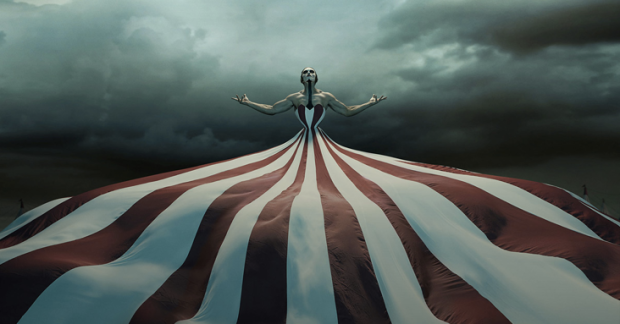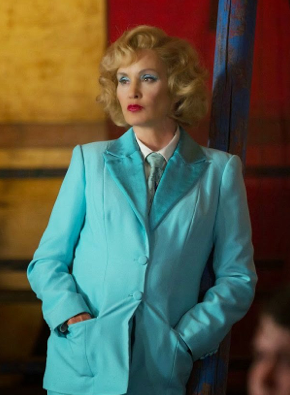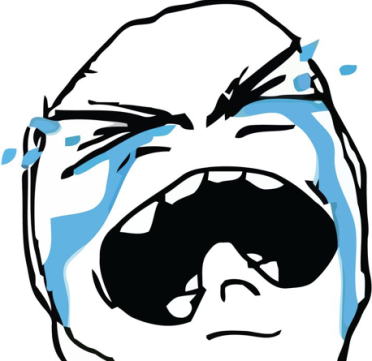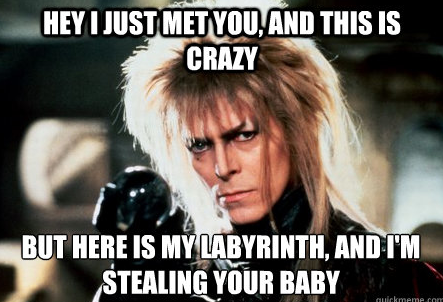Posts Tagged what makes a great villain
How to Create Legendary Villains
Posted by Author Kristen Lamb in Writing Tips on May 9, 2016

American Horror Story “Freak Show” on FX
This past Saturday I held my Bullies & Baddies class and a couple of the folks posited a really good question worth talking about. How do we write great villains? One of the reasons I love holding this class is that all stories require a core antagonist (who is responsible for generating the story problem in need of resolution), but there are different types of antagonists. All villains are antagonists but not all antagonists are villains.
But since we went there, what goes into creating a truly terrifying villain?
I watch a ton of movies and television series. I also read around three novels a week. I’m always studying, breaking stories apart so that I can understand them better. I do it for my fiction, but also so I can share what I learn with you guys.
Though the series isn’t for everyone (it’s pretty gory), I particularly love FX’s American Horror Story for studying villains. AHS is one of those shows that you have to get a few episodes into before you connect, namely because it is often cast with truly despicable characters.
It isn’t until you get a few episodes in that the writers start peeling back the layers and exposing the delicate undersides of the villains…and that’s when you really begin to care for them.
I know. Seriously. AHS is some of the best writing out there.
Jessica Lang almost always plays the core antagonist in each season of AHS (though she was absent in Season Five and it was evident). Of all the seasons, though, Season Four Freak Show was my favorite and that’s what I am going to use today. Btw, there is a bit of spoiler alert, but it’s necessary. So what do we do to really make the villain POP?
Give the Villain a Sympathetic Goal

Elsa Mars (via FX)
In Season Four of AHS, Lang plays Elsa Mars. Mars is a self-centered, lying, conniving, murderous woman. But she is a deeply flawed and tragic character. Her goal is two-fold. First, she wants to become a star in Hollywood. Secondly, she wants to build the best Freak Show in the world.
As a young woman, Elsa is victimized by a man who promises her the starring role in a movie. What he fails to tell Elsa is she has the starring role in a snuff film. He films another man taking a buzz saw to both of Elsa’s legs then leaves her for dead. Through the sympathy and miraculous skill of an artist-sculptor, she’s saved and given life-like prosthetics and appears “normal.”
But this tragedy creates a horrible insecurity. She starts the Freak Show because deep down, she knows she’s a freak too. This makes her feel almost a maternal duty to collect the disfigured. To gather the tragic souls the world casts away and give them a home.
The Villain is the Hero of His/Her Own Story
Elsa is a mother figure. Under the circus tent, her “children” are stars and they are a family. She knows what life outside the show is like for a freak (she’s lived it). She also appreciates that she is a very different kind of freak. She has the ability to blend into society. Her children do not.
Make the Villain Conflicted
Mars is a very troubled and conflicted character. Her goal to take care of her charges and her desire to become famous in Hollywood are always in conflict. Also what makes Elsa so good is also what makes her so bad. She is relentlessly ambitious (good), but she is relentlessly ambitious (bad).
Remember that our best self and our worst self are often opposing edges of the same blade. This is true for protagonists (heroes) as well.
I see this even in myself. I have a compulsive personality. This is good (1000+ blogs), but can be very, very bad. I latch onto something like a pit bull and don’t let go…but sometimes I’ve latched onto something I should let go of (every ex-boyfriend ever).
As I like to say…
There is a fine line between persistent and stupid.
The reason this duality makes for a layered villain is that great fiction acts as a mirror and reflects a degree of reality back to the reader. When the reader sees the duality of the villain, she is also seeing the duality in herself. That is the part that can be deeply disturbing.
Maybe we believe we are incapable of murder, but are we really? Or have we simply been blessed with the right life circumstances that have permitted us to never have to really get an answer to that question?
Give the Villain Noble Goals
To dovetail off the last point I made, Elsa does some truly detestable things…but we do see there is a not-so-evil motivation behind her actions. Thus, we sympathize and I think that is one of the ways a good villain can truly get to us.
We see the ugliness in ourselves, the great evil we might be capable of in the right situation.
Elsa is profoundly insecure. It’s part of the reason she created the Freak Show to start with. If she owns and runs the show, she can be the main attraction. But again, Elsa’s goals collide with the intensity of a tectonic plate shift.
She knows the show has to make money because she clothes and feeds and shelters her “monsters”. But, to be blunt? She’s also greedy. So when another act overshadows her own? Her greed and her insecurity collide.
Make the Villain’s End a Sad Event

For me, the best villains are the ones we almost are silently rooting for and are really bothered by that. Elsa is one of those characters that in one episode you hate her and in the next you’re rooting for her and the end of the season is beautiful and tragic.
My friend NYTBSA James Rollins says he knows he’s done his job when the reader cries for the villain at the end.
This is also why NYTBSA Allison Brennan and I have had a long-running argument that Hannibal Lecter is actually not a villain but an antihero. Allison thinks he’s a villain, but I posit that Hannibal is written SO well, he actually transcends those boundaries and becomes the antihero.
Y’all KNOW you cheered at the end of Silence of the Lambs when he said he was “having an old friend for dinner.” And what is SO EPIC about this is that the guy he is going to eat is a law abiding citizen who technically has done nothing illegal…but we still are rooting for Hannibal (a serial killer).
And that freaks us out more than a little bit.
Another great villain? The Goblin King from Labyrinth. Every woman over the age of 30 is still wondering why the hell Sarah didn’t take the deal.

Now For This Little Slice…
There is another kind of villain, a villain who deeply upsets us and who’s end is a joyous event. We cheer. We don’t want this type of villain defeated. We don’t want them dead.
We want them OBLITERATED. Salt the very earth of their soul.
Michael Connelly’s The Lincoln Lawyer has the best example of this type of villain. The movie is great but the novel? O…M…G. The villain is positively terrifying.
Why?
Namely because this villain exemplifies what we fear most (and what protagonist Mickey Haller also fears).
That we won’t recognize pure evil when we see it.
At first glance, Roulet is the guy every girl would love to land. He’s smart, rich, handsome and charming. But is is a stone cold killer who exacts suffering for his own pleasure. What makes this character so disturbing is, like Haller, we believe Louis Roulet is innocent and that he’s been the victim of a terrible scam.
So when we hit that pivot point where we realize we’ve been duped? It rattles us to the core.
This type of villain will exhibit the same traits mentioned above, but they are all a deception. This villain is a venus flytrap who looks like a good guy but is only death disguised.
In The Lincoln Lawyer, Roulet has a sympathetic goal. He is an innocent man who’s been set up by a prostitute who is framing him so she can sue him for damages in civil court and use him as her ticket out of turning tricks.
Roulet is conflicted. He fails to share various pieces of vital information with his lawyer because he is “protecting his mother.” He doesn’t want to upset her and he cares deeply about her perception of him (I.e. he fails to mention he was going to Reggie Campo’s place to pay for sex).
Roulet has noble goals. For instance, he explains that the reason he carries a knife is because he discovered his mother (also a real estate agent) raped and brutalized in a home she was showing. He tells Haller that real estate agents often meet clients in homes alone and there is no real way to vet that they aren’t psychos (um irony), so he carries for protection.
Notice how Connelly hits on ALL the notes of a villain, but camouflages them as a hero.
THIS is why our world turns upside down when we realize it is all a lie. Roulet does not have a sympathetic goal at all! He’s a sado-mysogynistic killer and his only goal is to exact suffering…then destroy another man’s life by framing him for his crime.
This villain is not conflicted at all. He is very well aware of what he’s doing. He’s narcissistic and believes he is above the rules that govern society.
He does not have noble goals. His goals are as black as they come. This is why, unlike a villain like Elsa Mars, when Roulet meets his end? We cheer. In fact, regarding this, I actually prefer the ending in the movie where Roulet is badly beaten by Haller’s motorcycle gang clients before being hauled to jail.
A good way to make this kind of villain work is to create a deflection. Cast an innocent character as the “villain”. It is essentially a “bait and switch.” In the case of Roulet, the prostitute he brutalized carried the mantle of villain until Act Two.
What are your thoughts? Does this help you understand how to give depth to your villains? What are some of your favorite villains from the page or even the screen?
I LOVE hearing from you!
To prove it and show my love, for the month of MAY, everyone who leaves a comment I will put your name in a hat. If you comment and link back to my blog on your blog, you get your name in the hat twice. What do you win? The unvarnished truth from yours truly. I will pick a winner once a month and it will be a critique of the first 20 pages of your novel.
Upcoming Classes!!!
Remember that all WANA classes are recorded so if you miss, can’t make it or just want to refresh the material, this is included with purchase price. The classes are all virtual and all you need is a computer and an Internet connection to enjoy!
Hooking the Reader—Your First Five Pages MAY 14th. The first five pages are one of our best selling tools. We fail to hook the reader and that is a lost sale. In this class, we go over the art of great beginnings. Additionally, the upper levels Gold and Platinum I actually LOOK at your pages and critique your actual writing. I am offering DOUBLE PAGES for FREE so this is a fantastic opportunity to get feedback from a pro.
When Your Name Alone Can SELL—Branding for Authors MAY 16th. The single largest challenge all writers face in the digital age is discoverability. In a sea of infinite choices, connecting with our audience can be a nightmare. Our brand is our lifeline. What is a brand? How do we create one? How do we entice an overwhelmed and distracted audience to connect and care? How do we develop this brand over time? How can we make this brand resilient to upheavals? How can this brand then grow and evolve as we grow and evolve?
Blogging for Authors MAY 20th. Blogging is one of the most powerful forms of social media. Twitter could flitter and Facebook could fold but the blog will remain so long as we have an Internet. The blog has been going strong since the 90s and it’s one of the best ways to establish a brand and then harness the power of that brand to drive book sales.
Anatomy of a Legendary Villain
Posted by Author Kristen Lamb in Antagonist on April 22, 2015
Before we get started, I’d like to remind anyone who wants a WAY better chance at winning my 20 Page Death Star Critique, that I have started the Dojo Diva Blog and we are talking about Beginnings, namely giving ourselves permission to be NEW. Comments and trackbacks on the Dojo Diva count double and, since it is a separate contest, there is a LOT better chance of winning.
Moving on. VILLAINS!!!!
The antagonist is the most critical part to any story. No antagonist, NO story. Villains are only a type of antagonist and though this type of character has the power to be legendary, often what we see in books, series and movies are mustache-twirling caricatures. Villains can easily become one-dimensional plot puppets.
As writers, we must get in the head of our villains as much if not more than the protagonist. The reason is that eventually our protagonist must eventually grow to become a hero, and this is not possible if we fail to appreciate the goals, conflicts and motivations of the villain.
Plain and simple: The villain creates the STORY problem and provides the crucible that will create a hero.
No Sauron and Hobbits remain in the Shire wishing for adventure. No Darth Vader and who cares about Skywalker? No Goblin King and Sarah never faces the Labyrinth and her own immaturity.
I recommend studying movies to understand story structure, but I feel TV series are better for understanding the character development of villains. The reason is that series are far more similar to full-length novels. We (the audience) have more TIME to understand the villain and see him or her at work.
Today, I’d like to talk about ways that we can give villains depth. Great villains have some similar “components.”
Remember, the villain is always the hero in his own story. Wanting to “rule the world” just to “rule the world” is for cartoons. If a villain is wanting to rule, control, destroy, etc. they should have a really good/plausible/sympathetic reason for doing so.
In fact, when we do a great job at creating the villain, our audience will struggle with who to root for.
Granted, we do run into great characters like Joker (Heath Ledger) who are chaotic evil, but though this type of character might be great for a Batman movie, he will be really tough to cast in a novel. Even then, I’d go so far as to say that Joker DID have an agenda. Whether it was trauma or madness, we get a sense that Joker believes there is no good in the world and is on a mission to prove any goodness can be corrupted.
Give the Villain a Sympathetic Goal
Remember that the beating heart of a story is CONFLICT. Antagonist wants X and Protagonist wants Y. Their goals conflict and only one can triumph at the end. No cheating. In act three the Big Boss Troublemaker must be defeated. Period. None of this well the reader meets my antagonist in Book Two…
Every story has an antagonist responsible for the story problem and he or she must be defeated or the story isn’t complete.
***In series, the protagonist will defeat proxies of the core antagonist. Each proxy serves as the core antagonist for that story.
To help you guys wrap your heads around what I am talking about, let’s look at television shows. I highly recommend the series Justified for dimensional villains. In every season we are introduced to a new Big Boss Troublemaker. Season one is the Skinhead Bank Robber Boyd Crowder. Season Two is the Hillbilly Mob Boss Mama Bennett. Season Three is the Detroit Mob Boss Robert Quarles who’s been exiled to Kentucky to fill the vacuum left by the defeat of the Bennett clan.
What I LOVE about Justified is that the characters are dimensional and interesting. Also, each season nicely dovetails into the next with authentic human problems. This isn’t just a series for those interested in writing about crime. There are genuine human problems in this series.
Today, though, I want to hone in on what I feel is one of THE best villains I’ve ever seen: Mama Mags Bennett.
What is Mags’ goal? Yes, she wants to rule Harlan, Kentucky and surrounding areas with an iron fist (and make a healthy profit), but deep down, she believes she is taking care of her flock. She maintains order in a world riddled with chaos. The area is steeped in poverty, endless economic depression, addicts, jailbirds, absentee parents, lost youth, and troublemakers and she provides authority, protection and structure.
Yes, she is taking advantage of the people, but believes she is the lesser of evils. Her family has been on that mountain for generations and have been there to pick of the pieces every time a corporation has raped the area after promising prosperity. She believes that there will be predators, so might as well go with the devil you know and the one who isn’t going to take all the timber, strip mine the minerals and ruin the land with slag.
And frankly, she has a good point.
Also, because the area is riddled with addicts, she knows that bigger predators have their eyes on the area (I.e. Miami Mafia and Mexican cartels) and have no concern for the people. Yes, she provides weed, meth and oxycotin, but also provides jobs and protection. She also protects members of the flock from smaller predators. For instance, she will NOT tolerate a child molester and goes biblical on anyone who crosses that line.
Thus, we as the audience see she kind of has a good point. The area will likely always be lawless, so why not be ruled by a local who cares for the community?
Contrast
Great villains have contrast. Contrast makes a villain sympathetic. If a villain is always torturing people and doing bad stuff simply to do bad stuff, the audience can’t really connect. We have to have some area where that villain is human.
The entire season (series ) is loaded with contrast and there is no character more conflicting that Mags Bennett. First of all, let’s just look at some of the surface contrast.
Hillbilly Mafia
Dixie Mafia
These words don’t go together. When we think of Mafia, we often think of black suits and shiny Lincolns. When we hear “Dixie” we think of line-dancing, moonshine and banjos. We don’t default to dirty flannel, banjos and ruthless drug enforcers.
Yet, one element that has always made mob members so intriguing is their loyalty to family.
Helloo? Ever heard of the Hatfields and McCoys?
This area of the country is steeped in a profound loyalty to clan and family, thus it unexpectedly makes the perfect mob story.
Mags is so interesting namely because we can never seem to get a bead on her. When we meet her, she seems to be this sweet, gentle grandmotherly figure (which she is). She runs a country store and makes sure the local families can use their food stamps and welfare checks to put food on the table.
Yet, this same matronly character is later seen breaking her son’s fingers with a hammer because his bad decisions have jeopardized their larger operations and brought the attention of federal marshals. Granted, she cries the entire time and hates having to “correct” her son, but she knows if she shows any weakness of favoritism with her own kin, she will lose power and respect.
Thus, we SEE this woman do terrible things, but she always has a sympathetic reason (as to point above). Yes, it is awful that she breaks her son’s fingers, but she is genuinely afraid her son’s idiocy will get him killed or imprisoned, thus her “chastisement” is the far less severe of the consequences.
In her mind, she is saving him from himself.
The Villain Fires the Conflict for the Protagonist
Great villains torment some part of the protagonist’s soul. For the protagonist, it can be black and white to take out a bad guy, but that isn’t nearly as messy. In the case of Justified Raylan Givens is a federal marshal who also grew up in the area. He knows Mags and even likes her. He is torn between his duty to uphold the law and his personal history and feelings.
Taking out Mags is emotionally messy. And, though Raylan is the perfect person to shut her down, he kinda wishes someone else could have the task. Mags brings back old guilt, memories, shame, regrets and baggage.
Make The Villain’s End a SAD Thing
In Justified we hate Mags, we are rightfully afraid of her, but we also feel for her. She does a lot of really awful things, and though we want her stopped, we want her undoing to be appropriate. She’s like a man-eating bear. Sure we want the bear to be put down, but caging it and putting it in the circus seems unreasonable and unfit.
When Mags is taken down, we walk away feeling that her end was just and appropriate to the apex predator she was.
What are your thoughts? Do you think series are better for exploring villains and antagonists? Do you think they are a better cross-comparison with a novel? What are some series with memorable villains? How did the villain leave you conflicted? Did you find yourself rooting for the villain and little bit sad when he or she lost?
I love hearing from you!
To prove it and show my love, for the month of APRIL, everyone who leaves a comment I will put your name in a hat. If you comment and link back to my blog on your blog, you get your name in the hat twice. What do you win? The unvarnished truth from yours truly. I will pick a winner once a month and it will be a critique of the first 20 pages of your novel, or your query letter, or your synopsis (5 pages or less).
For those who need help building a platform and keeping it SIMPLE, pick up a copy of my latest social media/branding book Rise of the Machines—Human Authors in a Digital World on AMAZON, iBooks, or Nook.













